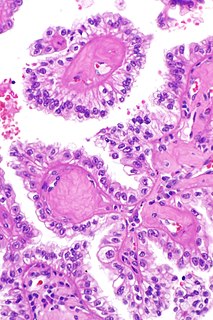
Hysterectomy is the surgical removal of the uterus. It may also involve removal of the cervix, ovaries, fallopian tubes and other surrounding structures.
Heavy menstrual bleeding, previously known as menorrhagia, is a menstrual period with excessively heavy flow and falls under the larger category of abnormal uterine bleeding (AUB).

A leiomyoma, also known as fibroids, is a benign smooth muscle tumor that very rarely becomes cancer (0.1%). They can occur in any organ, but the most common forms occur in the uterus, small bowel, and the esophagus. Polycythemia may occur due to increased erythropoietin production as part of a paraneoplastic syndrome.
Vaginal bleeding is any bleeding through the vagina, including bleeding from the vaginal wall itself, as well as bleeding from another location of the female reproductive system, often the uterus. Generally, it is either part of a normal menstrual cycle or is caused by hormonal or other problems of the reproductive system, such as abnormal uterine bleeding.

Hysteroscopy is the inspection of the uterine cavity by endoscopy with access through the cervix. It allows for the diagnosis of intrauterine pathology and serves as a method for surgical intervention.

An endometrial polyp or uterine polyp is a mass in the inner lining of the uterus. They may have a large flat base (sessile) or be attached to the uterus by an elongated pedicle (pedunculated). Pedunculated polyps are more common than sessile ones. They range in size from a few millimeters to several centimeters. If pedunculated, they can protrude through the cervix into the vagina. Small blood vessels may be present, particularly in large polyps.

Uterine fibroids, also known as uterine leiomyomas or fibroids, are benign smooth muscle tumors of the uterus. Most women have no symptoms while others may have painful or heavy periods. If large enough, they may push on the bladder causing a frequent need to urinate. They may also cause pain during sex or lower back pain. A woman can have one uterine fibroid or many. Occasionally, fibroids may make it difficult to become pregnant, although this is uncommon.

Myomectomy, sometimes also fibroidectomy, refers to the surgical removal of uterine leiomyomas, also known as fibroids. In contrast to a hysterectomy the uterus remains preserved and the woman retains her reproductive potential.
Myoma is a kind of mesenchymal tumor.
INSIGHTEC Ltd., is a privately held medical device company that sells MR guided Focused Ultrasound equipment. The technology can destroy deep tissue in the body without the need for incisions.

Uterine artery embolization is a procedure in which an interventional radiologist uses a catheter to deliver small particles that block the blood supply to the uterine body. The procedure is done for the treatment of uterine fibroids and adenomyosis. This minimally invasive procedure is commonly used in the treatment of uterine fibroids and is also called uterine fibroid embolization.

Placenta accreta occurs when all or part of the placenta attaches abnormally to the myometrium. Three grades of abnormal placental attachment are defined according to the depth of attachment and invasion into the muscular layers of the uterus:

The uterine artery is an artery that supplies blood to the uterus in females.

Ulipristal acetate, sold under the brand name Ella among others, is a medication used for emergency birth control and uterine fibroids. As emergency birth control it should be used within 120 hours of sex. For fibroids it may be taken for up to six months. It is taken by mouth.

Sonalleve MR-HIFU is a medical system developed by Philips Healthcare for the treatment of uterine fibroids without surgery. The system uses non-invasive high-intensity focused ultrasound (HIFU) guided by magnetic resonance (MR), whence the acronym MR-HIFU. The procedure involves volumetric heating of fibroids with real-time feedback. In June 2017, Philips and Profound Medical announced an agreement to transfer Philips' MR-HIFU business, which includes the Sonelleve system, to Profound Medical.

Reed’s syndrome is a rare inherited condition characterised by multiple cutaneous leiomyomas and, in women, uterine leiomyomas. It predisposes for renal cell cancer, an association denominated hereditary leiomyomatosis and renal cell cancer, and it is also associated with increased risk of uterine leiomyosarcoma. The syndrome is caused by a mutation in the fumarate hydratase gene, which leads to an accumulation of fumarate. The inheritance pattern is autosomal dominant.
A morcellator is a surgical instrument used for division and removal of large masses of tissues during laparoscopic surgery. In laparoscopic hysterectomy the uterus is minced up, or morcellated, into smaller pieces inside the woman's abdominal cavity in order to extract from the abdomen. It can consist of a hollow cylinder that penetrates the abdominal wall, ending with sharp edges or cutting jaws, through which a grasper can be inserted to pull the mass into the cylinder to cut out an extractable piece.
Sonosalpingography (SSG), also known as Sion test, is a diagnostic procedure primarily used for evaluating patency of fallopian tubes. It was introduced as a screening procedure for infertility investigations. It is becoming more popular among practitioners due to absence of side effects.

Relugolix, sold under the brand name Relumina, is a gonadotropin-releasing hormone antagonist medication which is used in the treatment of uterine fibroids in Japan. It is also under development for use in other countries and for the additional indications of endometriosis and prostate cancer. It is taken by mouth once per day.












